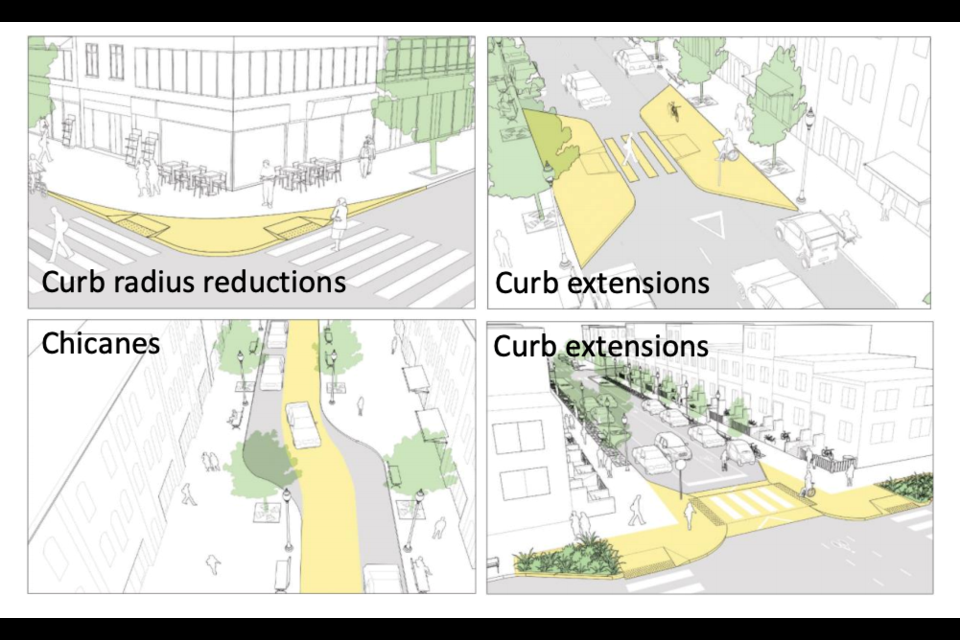The Town of Collingwood is working toward a new policy that would allow residents to petition the town to ask for traffic calming measures on their street.
According to town staff, the new policy would allow a consistent approach to those requests and create a “toolbox” the town could use to address issues such as speeding in residential areas.
“This is a first step for managing public safety on roads,” said Peggy Slama, director of public works, engineering, and environmental services for the town.
Members of council’s development and operations services standing committee heard about the eight-step proposed policy from the town’s manager of engineering services, John Velick, and Michael Cullip, a consultant with Tatham Engineering Ltd.
Cullip and Velick explained there are physical and non-physical measures a town can use to “calm” traffic on a road, which essentially is meant to reduce speeds and/or collision rates in an area.
Since there are pros and cons to slowing traffic down on a residential street, staff and Tatham consultants sought to create a policy that would weigh both before installing a physical or non-physical traffic calming measure.
The proposed policy states the exact traffic calming measures implemented in an area that qualifies will be determined on a case-by-case basis, the presentation included some examples such as:
- Speed humps
- Speed cushions (like a speed bump but with gaps in the humps to accommodate emergency vehicles and buses)
- Extending curbs to narrow an intersection or create an s-shaped curve on a street
- Installing centre medians
- Using a mini roundabout in an intersection to slow through traffic
- Speed tables (elevating a crosswalk or intersection)
- Adding on-street parking
- And non-physical measures such as pavement markings, signage, and increased speed enforcement
The policy suggests using resident requests as a trigger for staff to review an area for possible installation of traffic calming measures.
Step one requires a formal request with a petition including 51 per cent or more of those living on the street supporting traffic calming measures.
Step two follows a successful petition and initial screening, where the road in question must meet five criteria. The road must be considered a local road (collector roads could qualify on a case-by-case basis), it must have a daily average traffic volume of 900 vehicles, be at least 220 metres long without stop signs or traffic signals, have a grade below six per cent, and cannot have been part of a traffic calming request in the last five years.
If those requirements are met, staff will conduct a speed survey.
Step three is data collection to study traffic volume, collision records, pedestrian activity, and site-specific information.
Step four is creating a preliminary design that would be reviewed by emergency services, transit, and town operations for review and comment.
Step five is to notify the community and share the preliminary designs.
Step six is to prioritize all the locations that have qualified to this point based on the budget allocated for traffic calming work.
Step seven is to build and install the traffic calming measures with notices sent to local residents and posted publicly.
The final step (eight) is to monitor and evaluate the effectiveness of the measures and the impact on the surrounding road network.
Velick explained the town is also working with new development proposals to build in traffic calming measures where they are warranted.
Deputy Mayor Keith Hull said he’d like to see a lower threshold for the public petition, suggesting it not require 51 per cent of residents to support the idea of traffic calming measures.
Councillor Deb Doherty took issue with the formula the town would use to determine if there is speeding on the road, since traffic calming measures would only be implemented where speeding occurs.
In measuring speeding in areas, the town would be using a formula based on what speed the 85th percentile of cars are travelling. If it is 10 km over the posted limit of 50 km/h or five km over a community safety zone’s 40 km/h, then the road could qualify for traffic calming measures.
Doherty suggested it not be mandatory for a road to meet the speeding criteria if other criteria are met.
CAO Sonya Skinner reminded council the traffic calming policy is not a broad-range safety policy.
“Traffic calming, generally, by definition is to reduce speed,” said Skinner. “If you don’t have a speed problem, then your answer is probably not traffic calming.”
Instead, staff recommended looking into speed reduction as a separate matter.
“The policy didn’t look at reducing speeds town-wide,” said Velick. “That’s quite a significant policy change and I think it should be reviewed on its own in isolation.”
Staff did, however, look into one separate but related issue for the traffic calming policy because council asked for a report back on a formal policy for street play.
Using examples from Quebec and Toronto, council directed staff to consider the idea of using signage and temporary barricades on residential streets to allow kids and families to use the street for play. In some cities, the speed limit is lowered during set times to reduce traffic volume while the streets are being used for play.
Velick said the examples staff found were from urban areas with dense population and limited access to green spaces.
In most cases, local residents set up the temporary equipment to indicate street play times, which drew strong objections from the Town of Collingwood’s insurers.
Velick said he does not recommend a street play initiative for Collingwood.
“Staff are of the opinion that children should be encouraged to play in parks and on the trails,” he said, adding there are no bylaws or Highway Traffic Act laws preventing the playing of sports or games on town streets.
The proposed traffic calming policy and staff report is available online here. It is slated to be included on the May 31 council agenda for a full council vote.



